
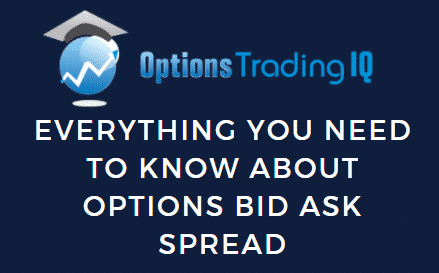
Today, we’re going to take a deep dive in to options bid ask spreads.
By the end you understand what they are, how to analyze them and learn what to look for to give you a higher probability of success with your trades.
We’ll also scrutinize different stocks to see which have wide bid ask spreads and why that can have a negative impact on your trading.
We’ll also look at the difference is spreads for at-the-money and out-of-the-money calls and puts and finally we’ll look at what happens to spreads during volatility events.
Enjoy!
Contents
- Option Bid Ask Spread Explained
- Why Is It Important
- Some Tips on Order Entry
- Bid Ask Spreads on Different Instruments
- Bid Ask Spreads on Different Option Strikes
- What About Different Months?
- FAQ
- Summary
Option Bid Ask Spread Explained
For any financial instrument, be it a stock or an option, there is a bid price and an ask price.
The bid price is the best (highest) price someone is willing to buy the instrument for.
The ask price is the best (lowest) price someone is willing to sell the instrument for.
Makes sense if you think about it.
Bid = buy. Therefore, the buyer wants the lowest possible price.
Ask = sell. Therefore, the seller wants the highest possible price.
The mid prices is therefore right in between where the buyers and sellers are.
Let’s look at a simple example:

Why Is It Important
When looking at a particular instrument for trading, it is important to check the bid-ask spread. Wide spreads can increase the costs of trading in that instrument via something referred to as “slippage”.
Slippage just means not getting filled at a good price. When a stock or option has a wide bid-ask spread, sometimes you can get filled at the mid-point, but sometimes you have to give up $0.05 or $0.10 to get into the trade.
This can result in negative P&L right from the outset and put you behind the 8-ball.
Remember that slippage can occur on trade entry, adjustment and exit so that can mean a lot of slippage if you are trading an instrument with a wide spread.
Some Tips on Order Entry
When buying an option or a stock, we click on the ask price, but we don’t want to pay the ask price, we want to be somewhere near the mid price.
With an instrument like SPY, that’s not really a concern because the spread is so tight, but with other instruments with a wide spread it’s crucial to get a good fill price.
Let’s say we have an option that has a bid of $2.00 and an ask of $2.60 and we want to buy it.
We click on the $2.60 but then we change the price to the mid-point of $2.30.
Actually, what I do is I start my order below the mid-point, say $2.20 in this case. It usually won’t get filled, so I then gradually increase my price until I’m at the mid-point where it sits and hopefully gets filled.
Other times, to ensure a good fill, I’ll leave the buy order at $2.20 and hope that market comes back to my price and I get filled.
Sometimes the market moves the other way and I miss out on getting into the trade. That doesn’t bother me because there will always be other trade opportunities and getting good fills is important. I don’t want to force trades.
Bid Ask Spreads on Different Instruments
Let’s put theory into practice and look at the bid-ask spreads for various different underlying instruments.
SPY is the most highly liquid stock or ETF in the market. The bid price at the time of writing is 357.98 and the ask price is 357.99.
That’s a $0.01 spread or basically no spread at all, especially when taken in percentage terms.
MSFT is another highly liquid stock and the spreads there are very good also at only $0.21 or about 0.09%.
The next example is a penny stock called IHT. The spread is huge at $0.47 on a stock that’s only trading at around $1.00. That’s basically a 50% spread!!
Next, we’ll compare some options on a highly liquid ETF (SPY) and a less liquid stock (TEAM).
Here again, SPY wins by a long way with spreads of only 1-3% whereas TEAM has spreads of 79% and 106%.
It’s going to be MUCH HARDER to filled at the mid-point on TEAM options than it is on SPY options. Not impossible, but definitely harder.
And remember that slippage occurs on entry, adjustment and exit.
For this reason, it is essential that beginner traders stick with highly liquid stocks and options with tight bid-ask spreads.
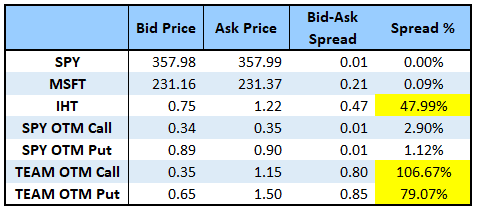
Bid Ask Spreads on Different Option Strikes
Clearly not all options are created equal and some stocks will have better option spreads than others.
But what about different options within the option chain? Do at-the-money options have tighter spreads than out-of-the-money options?
What about options across different time periods?
Let’s take a look and see what we find.
Taking a look first at SPY we can see that the at-the-money and out-of-the-money calls have a very low spread but that spread gets a lot wider for the in-the-money calls.
Looking at the chart below we can see that 355 and above calls have spreads of around $0.05 or less but the spread gradually gets larger the further in-the-money the strikes move, up to a maximum of about $1.00.
This data is using 45 day to expiration SPY options from September 2, 2020.
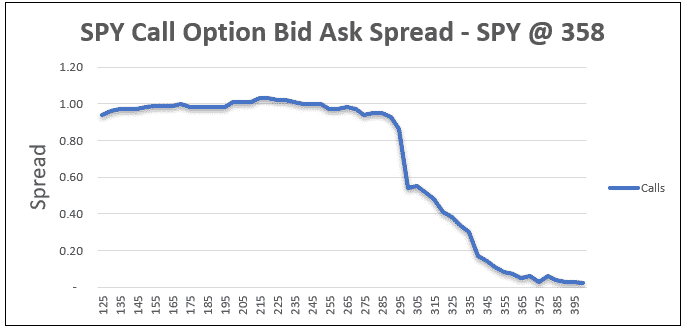
It’s a similar story with the puts where the at-the-money and out-of-the-money puts have a tight spread, but the in-the-money spreads start to blow out.
One point worth noting here is that the very far out-of-the-money options will naturally have a tighter spread. For example, options that are trading for only $0.05 or $0.10 shouldn’t have a $1.00 spread.
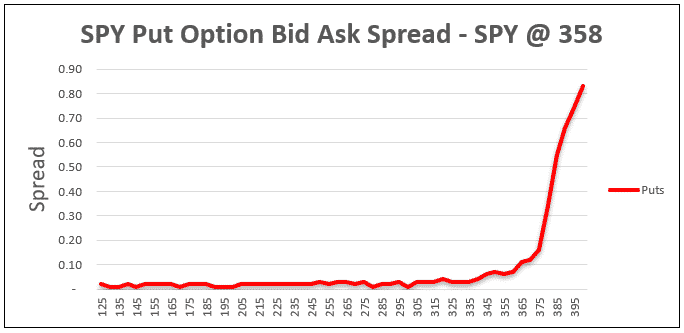
When we analyze the spreads in terms of a percentage of the option price, we get a slightly different story.
In terms of percentage, the spreads are widest for the out-of-the-money options in both cases.
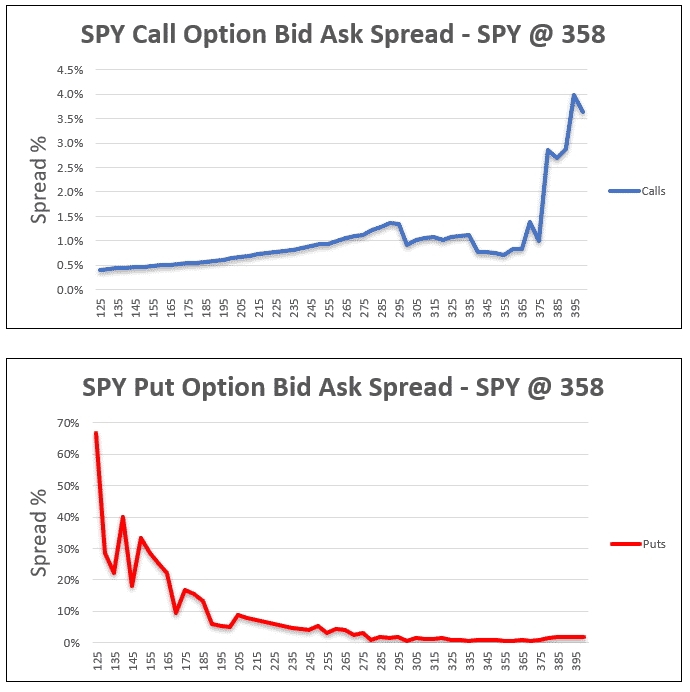
What About Different Months?
So far we’ve looked at SPY spreads for calls and puts across the one expiration period, what if we look at different expiry months.
Do you think long-term options will have wider spreads?
Let’s take a look and see.
We’ll take the furthest expiration we can find which in September 2020 was the December 16, 2022 expiry.
Here we can see the bid-ask spreads are generally much higher but that’s not unexpected because these long-term options will have much lower liquidity.
The calls are pretty consistent with a spread of around $1.80 and the puts also trade with spreads as high as $1.80.
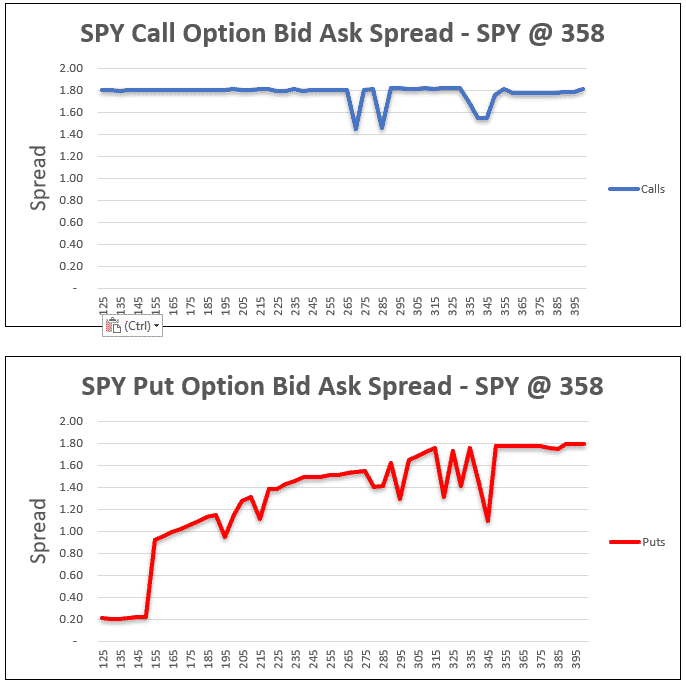
What Happens To Bid Ask Spreads During Volatility Events?
Bid-ask spreads will widen when volatility picks up and the market starts moving quickly.
From mid-February 2020 to late March 2020 volatility experienced a huge spike amid the coronavirus pandemic.
The VIX index jumped from around 14 to 85 in the space of a few weeks.
Let’s take a look at what happened to the bid-ask spreads for at-the-money SPY options during that period.
We’ll use the April expiration and look at a spreads before, during and after the spike.
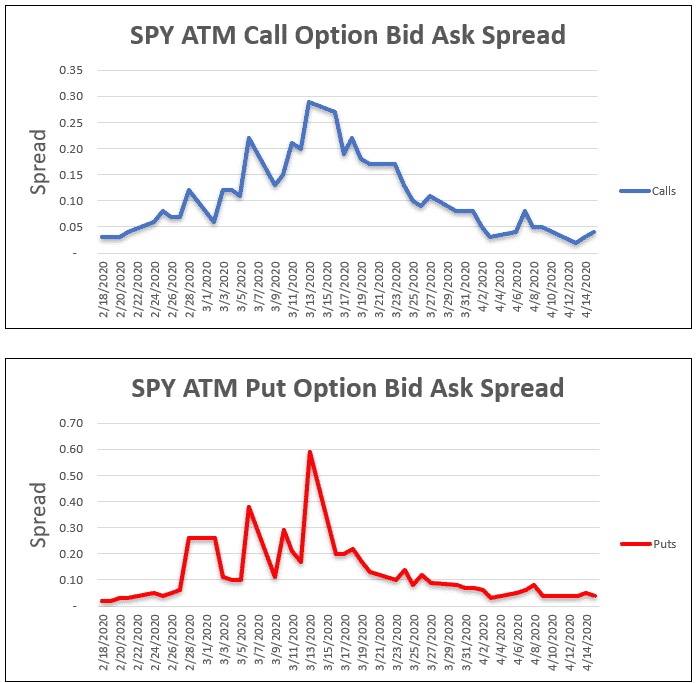
Here we can see a clear widening of the bid-ask spreads during volatility spikes. Remember this is for SPY, the most liquid underlying that there is.
Spikes would have occurred across all underlying stocks and ETF’s, perhaps to a larger extent.
FAQ
What Is Bid-Ask Spread In Options Trading?
The bid-ask spread in options trading refers to the difference between the highest price a buyer is willing to pay for an option (the bid) and the lowest price a seller is willing to accept (the ask).
It represents the cost of trading and liquidity in the options market.
Why Is Bid-Ask Spread Important In Options Trading?
The bid-ask spread is important in options trading because it affects the cost of buying and selling options.
A wider bid-ask spread can increase transaction costs and make it more difficult to execute trades, while a narrower spread can make trading more efficient.
How Can I Find The Bid-Ask Spread For An Option?
You can find the bid-ask spread for an option by looking at the options chain for that particular option.
The bid and ask prices will be listed, and the difference between them is the bid-ask spread.
You can also use a trading platform that provides real-time market data to see the bid-ask spread for multiple options simultaneously.
What Factors Affect The Bid-Ask Spread?
Several factors can affect the bid-ask spread in options trading, including the volatility of the underlying asset, the liquidity of the options market, the time to expiration, and the strike price of the option.
How Can I Minimize The Impact Of Bid-Ask Spread On My Trades?
You can minimize the impact of bid-ask spread on your trades by trading options with a narrower spread, such as those with high liquidity or low volatility.
You can also use limit orders to control the price at which you buy or sell options, and avoid trading options with wide spreads or low volume.
Is Bid-Ask Spread The Only Cost Of Trading Options?
No, bid-ask spread is not the only cost of trading options. Other costs may include commissions, fees, and slippage, which can affect the overall profitability of your trades.
It’s important to consider all of these costs when evaluating the potential profitability of an options trade.
Summary
Some key things to take away from today’s article:
- Slippage can add up, so it’s best to focus on high liquidity stocks and options with tight bid-ask spreads.
- SPY is the best underlying instrument for option traders in terms of bid-ask spreads.
- Less liquid stocks can have wide spreads which can result in significant slippage.
- In-the-money options have wider spreads than at-the-money and out-of-the-money options (but not necessarily in percentage terms)
- Longer-dated options have wider spreads than short-term options.
Trade safe!
Disclaimer: The information above is for educational purposes only and should not be treated as investment advice. The strategy presented would not be suitable for investors who are not familiar with exchange traded options. Any readers interested in this strategy should do their own research and seek advice from a licensed financial adviser.











Very good information provided. Thanks.
You’re welcome
Best article on that subject I’ve read.
Very kind. Thanks.
Very well written!
This question might be getting beyond, but I use Etrade. When buying or selling options, I always use limit orders, however if I need to roll an option up and out, or down and in, generally the orders won’t fill unless I use Market orders (unfortunately, the bid – ask spreads on the “buy to close” and the “sell to open” can be wide. It’s tough to know exactly how the order will fill. I’ve tried using a “Price type” of net credit, instead of market, but they never fill. I’d be interested in how you roll options. Thanks much!
Hi David, If it’s a spread trade and I’m not getting a fill on the limit order, I will break up the legs and execute them individually. If you’re having trouble getting filled on single orders, that could be a broker issue.